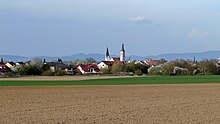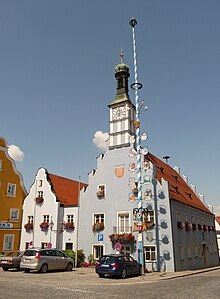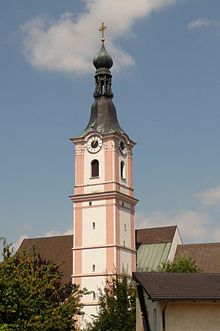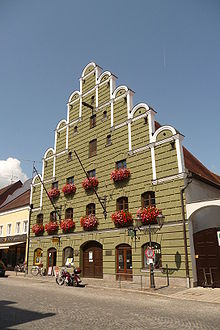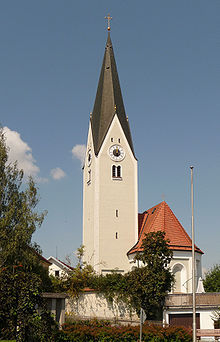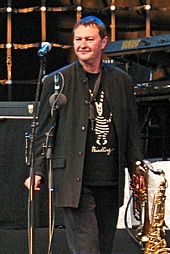Geiselhöring
| coat of arms | Germany map | |
|---|---|---|

|
Coordinates: 48 ° 50 ' N , 12 ° 24' E |
|
| Basic data | ||
| State : | Bavaria | |
| Administrative region : | Lower Bavaria | |
| County : | Straubing arch | |
| Height : | 356 m above sea level NHN | |
| Area : | 99.85 km 2 | |
| Residents: | 6824 (Dec. 31, 2019) | |
| Population density : | 68 inhabitants per km 2 | |
| Postal code : | 94333 | |
| Area code : | 09423 | |
| License plate : | SR , BOG, MAL | |
| Community key : | 09 2 78 123 | |
| LOCODE : | DE GIO | |
| City structure: | 49 districts | |
City administration address : |
Stadtplatz 4 94333 Geiselhöring |
|
| Website : | ||
| Mayor : | Herbert Lichtinger ( CSU ) | |
| Location of the town of Geiselhöring in the Straubing-Bogen district | ||
Geiselhöring is a town in the Lower Bavarian district of Straubing-Bogen .
geography
The city is located in the Danube Forest region in the valley of the Kleine Laber . At Geiselhöring, the Labertal flows into the Gäuboden , Bavaria's granary.
City structure
There are 49 districts:
There are the districts Geiselhöring, Hainsbach, Hirschling, Oberharthausen, Pönning, Sallach and Wallkofen.
history
Until the 19th century
Traces of early settlement can be proven by several archaeological finds. During the construction of the outdoor pool, for example, the so-called Geiselhöringer bull, a 16 cm tall clay cattle figure from the Neolithic Age, was discovered. There is also an earthwork and several Celtic entrenchments in the municipality .
The place name indicates a Bavarian town founded by a tribal nobleman named Giselher or Gisilher (name formation with affiliation suffix -ing ). This Giselher probably built a first settlement in the area of today's parish church, on the castle moat. The first documentary mention dates back to 1140 as Gisilheringen . In 1287 it was raised to the market as hostage herring . In the area of today's Linskirche a second settlement core developed and over time both grew together. Geiselhöring belonged to the Landshut Rent Office and the Kirchberg Regional Court of the Electorate of Bavaria. Here was an open courtyard of the Obermünster monastery. In addition, Geiselhöring had a market court with extensive magistrate rights.
After a devastating fire in 1504, the Gothic town hall was built in 1525, which is still the seat of the city administration today. Several proud gabled houses emerged over time, such as the magnificent town house. Today's coat of arms, a silver harrow on a red background, is attested for the first time as a market seal from 1514. The Thirty Years' War also left its mark on Geiselhöring.
Geiselhöring was the scene of important markets for centuries, at Maria Magdalena in July and Kathrein in November. The large cattle markets on the cattle market square were particularly well known. The last market was closed in 1977. The market took off with the construction of the railway in 1860, the royal Bavarian Eastern Railway . Geiselhöring was for a short time a central hub in the European rail network. This resulted in a noticeable economic and social upswing. In 1862 the largest sports club in the area, the TV 1862 Geiselhöring, which still exists today, was founded. Under his direction, the widely known Schäfflertanz has taken place every seven years since 1893 .
20th century
After the Second World War , the market was a place of refuge for many displaced people and the number of inhabitants skyrocketed. In 1952, Geiselhöring was elevated to the status of town by the then Bavarian Interior Minister Wilhelm Hoegner (SPD) . On this occasion, the market square at that time and today's town square were also fortified and given their typical paving. As part of the district reform, the Mallersdorf district was dissolved on July 1, 1972 and Geiselhöring came to the newly founded Straubing-Bogen district.
On April 16, 1980, a prototype of the tornado fighter plane crashed near Geiselhöring. Both test pilots were killed.
Incorporations
On January 1, 1972, the previously independent municipality of Greißing was incorporated. Hadersbach followed on July 1, 1972. On May 1, 1978, Haindling, Hirschling, Oberharthausen, Pönning, Sallach and Wallkofen (with the town of Pullach, which was incorporated on January 1, 1964) as well as parts of the dissolved community of Hainsbach were added.
Population development
| year | 1840 | 1871 | 1925 | 1939 | 1950 | 1961 | 1970 | 1987 | 1991 | 1995 | 2000 | 2005 | 2010 | 2015 | 2017 |
| Residents | 4234 | 5697 | 5945 | 5465 | 7904 | 5883 | 5708 | 5765 | 6099 | 6443 | 6603 | 6765 | 6639 | 6870 | 6890 |
politics
Mayor of Geiselhöring since 1945
| Term of office | Surname | Political party |
|---|---|---|
| Feb. 2015-2026 | Herbert Lichtinger | CSU |
| Oct. 2014 – Feb. 2015 | Josef Rothammer | (appointed as state commissioner to conduct business until a new mayor was determined by the by-election) |
| May 2014 – Oct. 2014 | Herbert Lichtinger | CSU |
| 2008-2014 | Bernhard Krempl | FW |
| 1984-2008 | Franz Xaver Stierstorfer | FW |
| 1966-1984 | Alfred Heindl | FW |
| 1952-1966 | Frank | SPD |
| 1945–1952 | Young farmers | SPD |
Allocation of seats in the city council
| Election year | CSU | FW | SPD | The citizens | total |
| 2015 (by-election) | 10 | 7th | 3 | 0 | 20th |
| 2008 | 10 | 7th | 2 | 1 | 20th |
| 2002 | 9 | 9 | 2 | - | 20th |
| 1996 | 9 | 8th | 3 | - | 20th |
Currently, Harry Büttner (SPD) is second mayor and Johann Bauer (CSU) is third.
Election manipulation in 2014 and by-election in 2015
The 2014 local elections were suspected of having been manipulated . The background to this was the fact that of the 482 registered Eastern European harvest workers, 465 had cast their vote, 460 of them by postal vote . These were only reported shortly before the election and, according to the Süddeutscher Zeitung, most of them do not have any knowledge of German. A CSU candidate who employed the harvest workers, her friends and relatives, who were also candidates on the CSU list, as well as CSU mayoral candidate Lichtinger, who, after the count, ultimately had a lead of around 300 votes over the incumbent mayor, benefited from this Free voter, Bernhard Krempl, had. Never before had a CSU candidate won in Geiselhöring. It was noticeable that not only were the same candidates always chosen, but also that the same pen was used for 433 of the 460 postal ballot papers and that the digits looked very similar. It is also disputed whether the harvest workers have their center of life in Germany and were therefore entitled to vote at all . Investigations are currently underway by the public prosecutor's office, the criminal police and the Bavarian State Criminal Police Office . In September 2014, the supervisory authorities announced the impeachment of the mayor elected on March 16, 2014, the city and district councils and new elections.
On February 1, 2015, the by-election for the mayor and city council took place. The CSU candidate Herbert Lichtinger was elected mayor with 61%. The district office had previously announced that none of the mayoral candidates and the city council candidates were under investigation and therefore none of the candidates was connected to the election manipulation. The CSU city council candidate, who is at the center of the investigation, had previously announced that she was no longer available for the city council list and was clearing the way for a new beginning. A short time later she also resigned from the CSU.
coat of arms
| Blazon : "Under the shield head with the Bavarian diamonds in red an erected silver harrow." | |
Culture and sights
- Historic town hall from 1525, rebuilt in the 17th and 18th centuries. Century, gable with battlements and baroque turrets
- Baroque parish church of St. Peter and Erasmus . It was built from 1761 to 1764 by master builder Georg Fischer using medieval components. The nave fresco of the Crucifixion of Peter was painted by Matthäus Günther in 1765 , the stucco and the stucco marble altars are by Franz Xaver Feuchtmayer (Feichtmayr). Due to its furnishings, the Geiselhöringer parish church is one of the most beautiful country churches in Lower Bavaria .
- Loichinger house from the 16th / 17th centuries Century, bourgeois trading house with rough plaster and stepped gable, hand-carved door around 1700
- Linskirche St. Jakob , originally Romanesque, choir and tower late Gothic, nave flat, in the 17th / 18th centuries Century changed
- Maritime Museum
- Schäfflertanz (every 7 years, again in 2019)
- Double church complex of the old Marian pilgrimage site in Haindling
- Baroque village church of the Assumption in Hadersbach
- Pilgrimage church in Antering
- Rococo church St. Martin in Pönning
- Three-part Celtic square hill near Greißing
- Eva-Plenningerin open-air festival (every four years, again in 2020)
- Schäffler Fountain
- City chapel Geiselhöring
- Sallach Castle
Economy and Infrastructure
economy
In 2017, according to official statistics, there were 171 employees in the field of agriculture, forestry and fishing, 1010 in the manufacturing sector and 339 in the field of trade, transport and hospitality. In other economic sectors 326 people were employed at the place of work subject to social security contributions. There were a total of 2809 employees at the place of residence subject to social security contributions. There were seven companies in the manufacturing sector and six in the construction sector. In 2016 there were 154 farms with a total of 6,444 hectares used for agriculture, of which 6,776 hectares were arable land and 306 hectares were permanent green space.
In 2011, the Bavarian Potato Center, the largest potato marketer in Bavaria, opened a second location in Geiselhöring. The company ensures long-term sales opportunities and prospects for regional agriculture.
The largest employer is the auto supplier Faurecia , which mainly produces car seats here.
traffic
- Road traffic
In the center of Geiselhöring, State Road 2111 ( Federal Motorway 3 - Obertraubling - Sünching - Geiselhöring - Mengkofen - Federal Motorway 92 - Dingolfing ) and State Road 2142 ( Straubing - Geiselhöring - Federal Road 15 ) meet. To relieve the through traffic of Geiselhöring, Hirschling and Perkam, a preliminary draft was approved by the Passau State Building Authority, which provides for the construction of a new 7.9 km relief section. In November 2007, the residents of Geiselhöring voted with a large majority in a referendum for the now planned Haindling Süd variant. Decades of political discussions preceded the referendum.
- Rail transport
Geiselhöring station is on the Neufahrn – Radldorf railway line .
- bicycle
Along the Kleine Laber, the Labertalradweg leads past Geiselhöring.
education
In 2018 there were the following institutions:
- In the day care center Geiselhöring children are looked after and supported in eight groups, three of which are children under three years of age. Another group is the forest kindergarten near Schelmenloh (since 2007).
- Geiselhöring primary school
- Geiselhöring middle school in association with Leiblfing, Mallersdorf-Pfaffenberg, Rain
- VHS branch office Laberweinting-Geiselhöring
Personalities
The following personalities come from Geiselhöring or had / have to do with Geiselhöring:
- Hans-Jürgen Buchner (born December 27, 1944) named his music group Haindling after the district of the same name
- Franz Xaver Engelhart (March 4, 1861 - July 14, 1924), choirmaster and composer
- Elli Erl (born May 25, 1979), winner of Germany is looking for the 2003 superstar
- Luise Kinseher (born January 4, 1969), cabaret artist and actress, born and raised in Geiselhöring
- Paul Mathias Padua (born November 15, 1903 - † August 22, 1981), painter, grew up in Geiselhöring
- Ignaz Saal (born July 26, 1761; † October 30, 1836), singer and actor, friend of Joseph Haydn and Ludwig van Beethoven
- Heinrich Weber (born February 21, 1940 - October 12, 2010), tenor
- Ida Krinner , country farmer, member of the state parliament (CSU) and senator
literature
- Josef Reindl: Geiselhöring. History of the market and the parish (including Greissing) . Michael Laßleben , Kallmünz 1936.
- Festschrift 700 years of market survey 1987, Festschrift 125 years TV 1862 Geiselhöring, chronicle of the town of Geiselhöring by Josef Reindl, brochure Geiselhöring 2000.
- Peter Stoll: Martin Heigl, Matthäus Günther and the parish church of Geiselhöring . In: Annual report of the historical association for Straubing and the surrounding area , 110. 2008 (2009), pp. 319–358.
Web links
Individual evidence
- ↑ "Data 2" sheet, Statistical Report A1200C 202041 Population of the municipalities, districts and administrative districts 1st quarter 2020 (population based on the 2011 census) ( help ).
- ↑ a b Local elections in the district of Straubing-Bogen. District Sraubing-Bogen, accessed on May 30, 2020 .
- ^ City of Geiselhöring in the local database of the Bavarian State Library Online . Bavarian State Library, accessed on September 20, 2014.
- ↑ District. Municipalities and districts. Bavarian Surveying Administration, archived from the original on April 11, 2013 ; accessed on March 31, 2015 .
- ↑ District. (PDF; 1.9 MB) Bavarian Surveying Administration, archived from the original on April 2, 2015 ; accessed on March 31, 2015 .
- ↑ a b c Wolf-Armin Frhr. von Reitzenstein : Lexicon of Bavarian place names. Origin and meaning. 2nd improved and enlarged edition. C. H. Beck, Munich 1991, ISBN 3-406-35330-4 , p. 154 .
- ^ Wilhelm Volkert (ed.): Handbook of Bavarian offices, communities and courts 1799–1980 . CH Beck, Munich 1983, ISBN 3-406-09669-7 , p. 516 .
- ^ Federal Statistical Office (ed.): Historical municipality directory for the Federal Republic of Germany. Name, border and key number changes in municipalities, counties and administrative districts from May 27, 1970 to December 31, 1982 . W. Kohlhammer, Stuttgart / Mainz 1983, ISBN 3-17-003263-1 , p. 632 .
- ^ City Council ( Memento from August 12, 2014 in the Internet Archive ). Website of the city of Geiselhöring. Retrieved July 27, 2014.
- ↑ a b Wolfgang Wittl: election scandal in Lower Bavaria - voting bloc on the asparagus farm. Süddeutsche Zeitung , September 18, 2014, accessed on September 20, 2014 .
- ↑ a b Björn Hengst: Election fraud in Bavaria: harvest workers as voting cattle. Der Spiegel , September 18, 2014, accessed on September 20, 2014 .
- ^ FW and ÖDP demand clarification . In: Süddeutsche Zeitung , July 27, 2014. Retrieved July 27, 2014.
- ↑ Investigations into election manipulation. The scent of asparagus . In: Süddeutsche Zeitung , April 3, 2014. Accessed July 27, 2014.
- ^ Suspected election fraud in Geiselhöring . In: Mittelbayerische Zeitung , March 20, 2014. Retrieved July 27, 2014.
- ↑ Entry on the coat of arms of Geiselhöring in the database of the House of Bavarian History
- ↑ Eva Plenningerin the festival in Geiselhöring. Retrieved January 22, 2019 (German).
- ↑ Geiselhöring primary school in the school database of the Bavarian State Ministry for Education and Culture , accessed on August 5, 2017.
- ^ Middle school Geiselhöring in the school database of the Bavarian State Ministry for Education and Culture , accessed on August 5, 2017.



